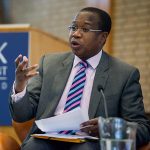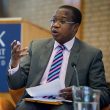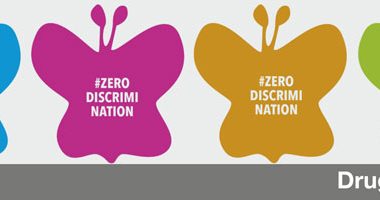ZIMBABWE President, Emmerson Mnangagwa, will champion the Operationalisation of the SADC Regional Development Fund when he takes over as Chairman of the regional bloc in August.
This was revealed by Finance, Economic Development and Investment Promotion Minister, Professor Mthuli Ncube in his address on Financing Industrial Developments to Attract Private Investments into the SADC Region at the Investment Conference at the ongoing 7th SADC Industrialisation Week in Harare.
“Distinguished Delegates, Ladies and Gentlemen, I am delighted to inform delegates that His Excellency the President of the Republic of Zimbabwe, Dr. Emmerson D. Mnangagwa has expressed interest in championing the Operationalisation of the Fund during his tenure as the SADC Chairperson.
“Consequently, I encourage Member States to commit to ratify the agreement and subsequently contribute towards the Fund as this shows our collective commitment to our development agenda,” Prof Ncube said.
President Mnangagwa takes over leadership of the regional bloc at the 44th Ordinary SADC Summit of Heads State and Government to be held on 17 August 2024 in Harare.
The objective of the SADC Regional Development Fund is to create a financial mechanism to mobilise resources from Member States, Development Partners and Private Sector to support regional development and deepening of regional integration as foreseen in Article 26A of the SADC Treaty.
An agreement already signed by some of SADC’s Member States stipulates that, the initial authorized capital for the Fund will be US$13 billion.
Each Member State is expected to contribute an initial subscription fee of US$120 million.
Member States will hold a majority shareholding of 51% in the Fund, while 37% will be allocated to the private sector with international cooperating partners holding the balance of 12%.
It is believed that operationalising the SADC Regional Development Fund will result in the establishment of shared cross-country infrastructure, which enables Member States to leverage international financing, share borrowing risks, and access a broader investor base with higher potential returns.
“In the Sub-Saharan Africa, the vast majority of infrastructure stems from the public sector and given limited fiscal space, the operationalisation of the RDF is key in bolstering infrastructure development to attract the private sector investments into the SADC region,” according to Prof Ncube.
SADC has focused on attracting investment which is crucial for economic growth and regional integration.
In 2006, SADC adopted the Protocol on Finance and Investment to promote investment in the region.
The Protocol encourages Member States to attract investors through favorable policies and legislation.
“The SADC Industrialization Strategy and Roadmap emphasize deeper integration to facilitate increased FDI inflows and integrate regional industries into global value chains. Member States are urged to implement these investment-friendly policies to attract FDI; increase production and productive; and facilitate technology and skills transfers,” Vice President Gen. (RETD) Dr Chiwenga said.
“We need competitive policies that attract and protect investments as well as incentivize private sector investment to stimulate economic growth.
“Since 2014 when SADC introduced the SADC Industrialisation Week, for the first time, this Industrialisation week comes with a special edition of an Investment Forum whose thrust is focused on investments in industrial infrastructure; spatial development; and industrial upgrading to modernise our equipment and catch up with the 4th industrial revolution. We are proud to have introduced this special element as the industrial agenda cannot be achieved without a corresponding drive to investment promotion,” Dr Chiwenga added









